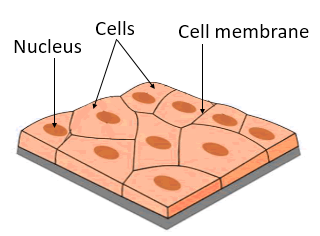
Tissue is defined as a structural organization of a group of similar or dissimilar cells that carry out a specific function.
(a)True
(b)False
Answer
505.8k+ views
Hint: The cells in a living organism are modified as per their functions and other requirements. Structurally similar cells perform similar functions while structurally different cells are specialized to perform different functions.
Complete step-by-step answer:
The body of plants and animals are composed of many types of cells and when many cells with similar structures are grouped so that they can perform a specific function in a coordinated manner, such a group of cells is termed as a tissue. Upon reading the sentence given in the question carefully, we can find that it says ‘a group of similar or dissimilar cells’ but as per the definition of tissue, it is a group of similar cells performing a similar function. The cells in a living organism are modified as per their functions and other requirements. A group of dissimilar cells can’t perform a single function in a well coordinated way because due to the difference in structure, they are specialized for different functions. Thus, the statement is not a true definition of a tissue. Representative diagram of a tissue has been given below –

Additional Information: -The cells in a tissue have the same origin and perform a specific function related to the life-sustaining processes of the living organisms. The tissues are further functionally grouped to form organs and in the organs, the tissue can be of different types.
-Human and animal tissues are studied in a separate branch of biology known as Histology whereas plant tissues are studied under a discipline called plant anatomy.
-For studying tissues, we need to make cross-sections in the tissues and for doing this, paraffin blocks are used.
So, the correct answer is ‘False’.
Note: The cells in a tissue have a similar origin and thus they are similar in structure and function. If two cells have different origins that means they are different in both the structure and functions and such cells can’t form tissue because it is a collection of cells that are similar in structure as well as function.
Complete step-by-step answer:
The body of plants and animals are composed of many types of cells and when many cells with similar structures are grouped so that they can perform a specific function in a coordinated manner, such a group of cells is termed as a tissue. Upon reading the sentence given in the question carefully, we can find that it says ‘a group of similar or dissimilar cells’ but as per the definition of tissue, it is a group of similar cells performing a similar function. The cells in a living organism are modified as per their functions and other requirements. A group of dissimilar cells can’t perform a single function in a well coordinated way because due to the difference in structure, they are specialized for different functions. Thus, the statement is not a true definition of a tissue. Representative diagram of a tissue has been given below –

Additional Information: -The cells in a tissue have the same origin and perform a specific function related to the life-sustaining processes of the living organisms. The tissues are further functionally grouped to form organs and in the organs, the tissue can be of different types.
-Human and animal tissues are studied in a separate branch of biology known as Histology whereas plant tissues are studied under a discipline called plant anatomy.
-For studying tissues, we need to make cross-sections in the tissues and for doing this, paraffin blocks are used.
So, the correct answer is ‘False’.
Note: The cells in a tissue have a similar origin and thus they are similar in structure and function. If two cells have different origins that means they are different in both the structure and functions and such cells can’t form tissue because it is a collection of cells that are similar in structure as well as function.
Latest Vedantu courses for you
Grade 10 | CBSE | SCHOOL | English
Vedantu 10 CBSE Pro Course - (2025-26)
School Full course for CBSE students
₹37,300 per year
Recently Updated Pages
Master Class 11 Economics: Engaging Questions & Answers for Success

Master Class 11 Business Studies: Engaging Questions & Answers for Success

Master Class 11 Accountancy: Engaging Questions & Answers for Success

Master Class 11 English: Engaging Questions & Answers for Success

Master Class 11 Computer Science: Engaging Questions & Answers for Success

Master Class 11 Maths: Engaging Questions & Answers for Success

Trending doubts
State and prove Bernoullis theorem class 11 physics CBSE

1 ton equals to A 100 kg B 1000 kg C 10 kg D 10000 class 11 physics CBSE

State the laws of reflection of light

One Metric ton is equal to kg A 10000 B 1000 C 100 class 11 physics CBSE

1 Quintal is equal to a 110 kg b 10 kg c 100kg d 1000 class 11 physics CBSE

Difference Between Prokaryotic Cells and Eukaryotic Cells




